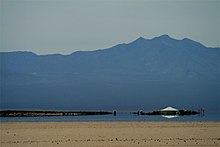MIRAGE
A mirage is a naturally occurring optical phenomenon in
which light rays are bent to produce a displaced image of distant objects or
the sky. The word comes to English via the French mirage,
from the Latin mirari,
meaning "to look at, to wonder at". This is the same root as for "mirror" and
"to admire".
In contrast to a hallucination, a mirage is
a real optical phenomenon that can be captured on camera, since light rays are
actually refracted to form the false image at the observer's location. What the
image appears to represent, however, is determined by the interpretive
faculties of the human mind. For example, inferior images on land are very
easily mistaken for the reflections from a small body of water.
Mirages can be categorized as "inferior" (meaning lower),
"superior" (meaning higher) and "Fata Morgana",
one kind of superior mirage consisting of a series of unusually elaborate,
vertically stacked images, which form one rapidly changing mirage.
vedio about mirage
Inferior mirage
For exhausted travelers in the desert, an inferior
mirage may appear to be a lake of water in the distance. An inferior mirage is
called "inferior" because the mirage is located under the real
object. The real object in an inferior mirage is the (blue) sky or any distant
(therefore bluish) object in that same direction. The mirage causes the
observer to see a bright and bluish patch on the ground in the distance.
Light rays coming from a particular distant object all travel
through nearly the same air layers and all are bent over about the same amount.
Therefore, rays coming from the top of the object will arrive lower than those
from the bottom. The image usually is upside down, enhancing the illusion that
the sky image seen in the distance is really a water or oil puddle acting as a
mirror.
Inferior images are not stable. Hot air rises, and cooler air
(being more dense) descends, so
the layers will mix, giving rise to turbulence. The image will be distorted
accordingly. It may be vibrating; it may be vertically extended (towering) or
horizontally extended (stooping). If there are several temperature layers,
several mirages may mix, perhaps causing double images. In any case, mirages
are usually not larger than about half a degree high (same apparent size as the
sun and moon) and from objects only a few kilometers away.
Heat haze
Heat haze, also called heat shimmer, refers to the inferior
mirage experienced when viewing objects through a layer of heated air; for
example, viewing objects across hot asphalt or through the exhaust gases
produced by jet engines. When appearing on roads due to the hot asphalt, it is
often referred to as a highway mirage.
Convection causes the temperature of the air to vary, and
the variation between the hot air at the surface of the road and the denser
cool air above it creates a gradient in the refractive index of the air. This
produces a blurred shimmering effect, which affects the ability to resolve
objects, the effect being increased when the image is magnified through a
telescope or telephoto lens.
Light from the sky at a shallow angle to the road is
refracted by the index gradient, making it appear as if the sky is reflected by
the road's surface. The mind interprets this as a pool of water on the road,
since water also reflects the sky. The illusion fades as one gets closer.
On tarmac roads it may look as if water, or even oil, has
been spilled. These kinds of inferior mirages are often called "desert mirages"
or "highway mirages". Both sand and tarmac can become very hot when
exposed to the sun, easily being more than 10°C hotter than the air one meter
above, enough to create conditions suitable for the formation of the mirage.
Heat haze is not related to the atmospheric phenomenon of
haze.
Superior
mirage
A superior mirage occurs when the air below the line of sight is colder than the air above it. This unusual arrangement is called a temperature inversion, since warm air above cold air is the opposite of the normal temperature gradient of the atmosphere. Passing through the temperature inversion, the light rays are bent down, and so the image appears above the true object, hence the name superior. Superior mirages are in general less common than inferior mirages, but, when they do occur, they tend to be more stable, as cold air has no tendency to move up and warm air has no tendency to move down.
RAY DIAGRAM OF IMAGE FORMATION










No comments:
Post a Comment